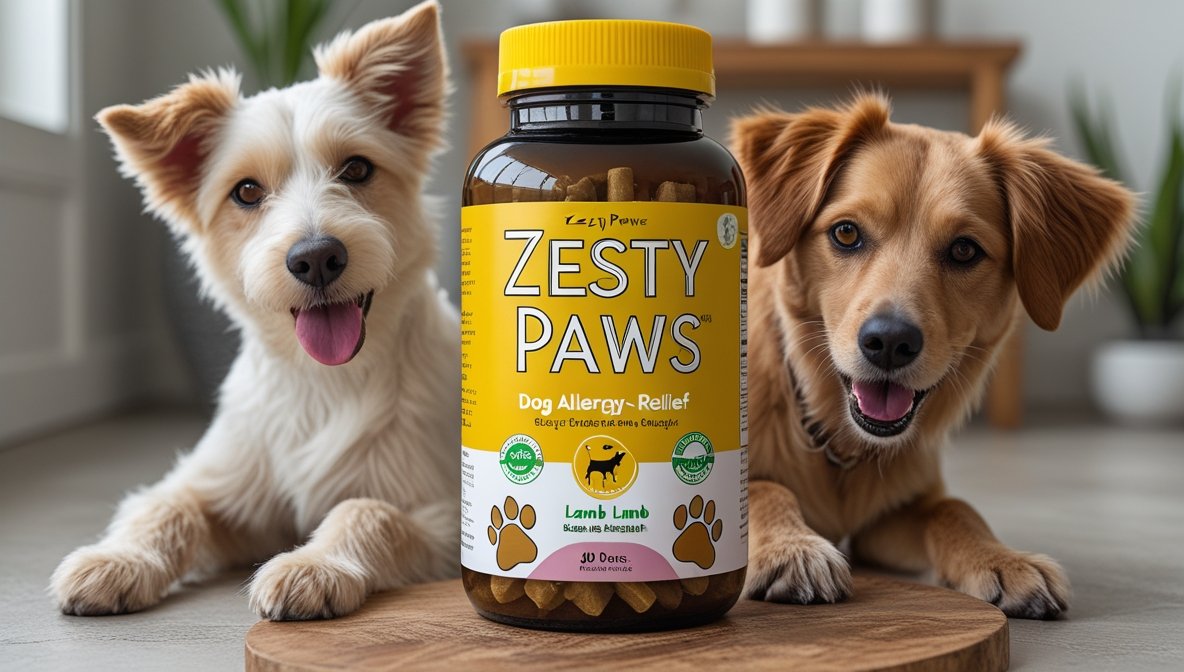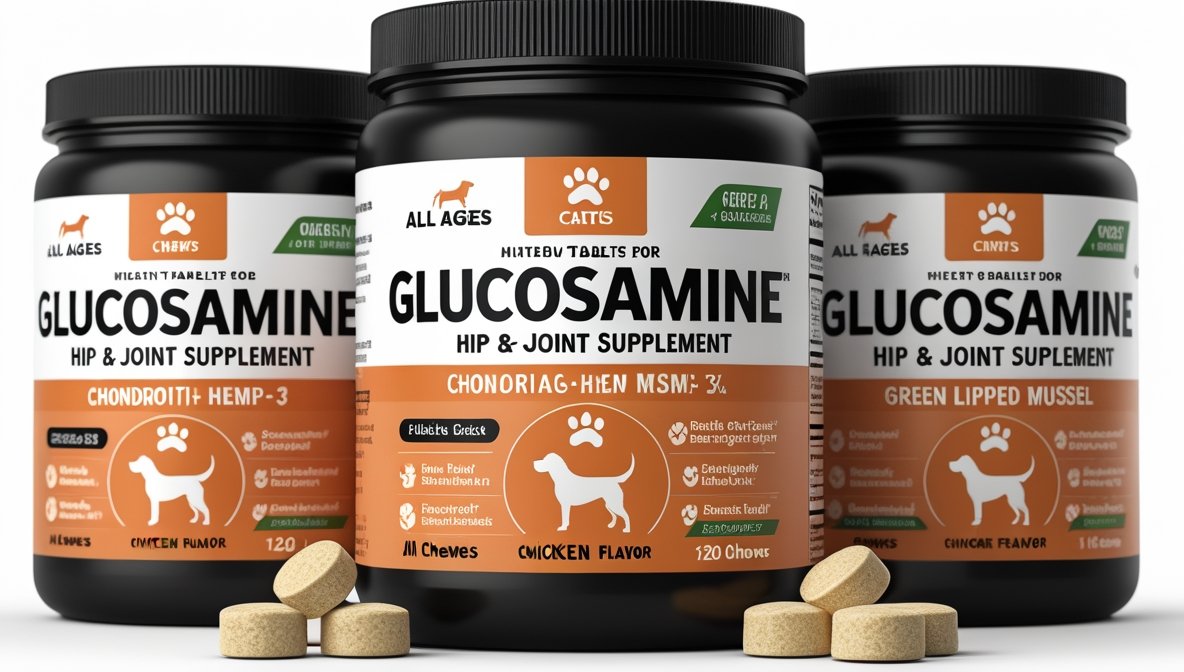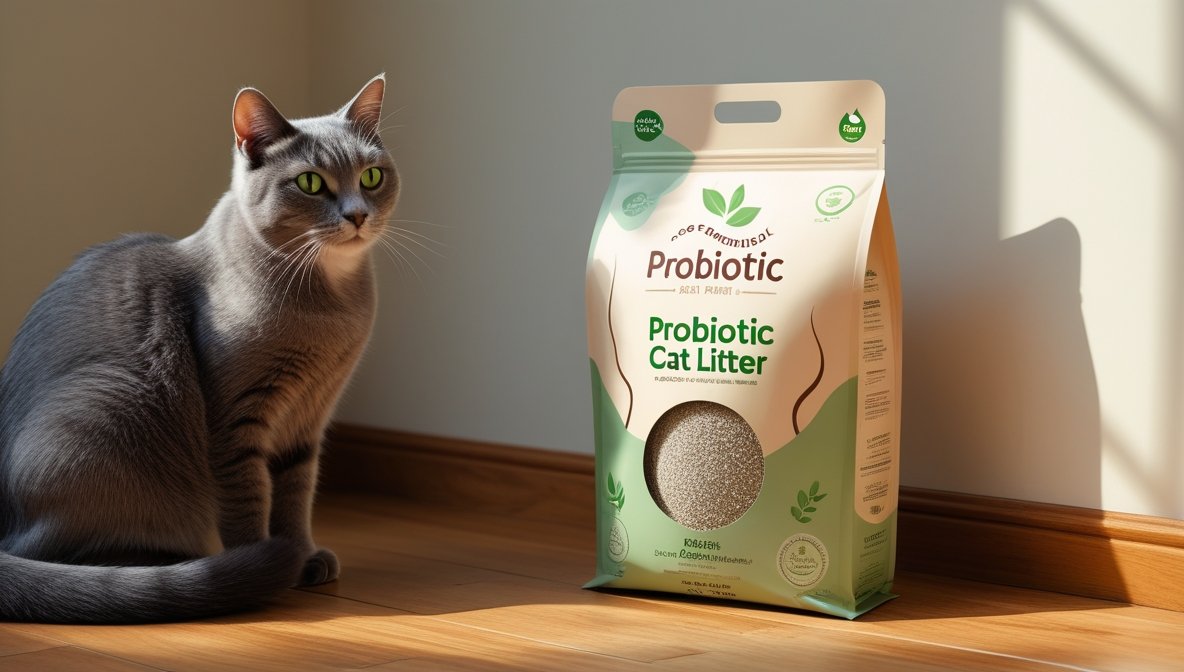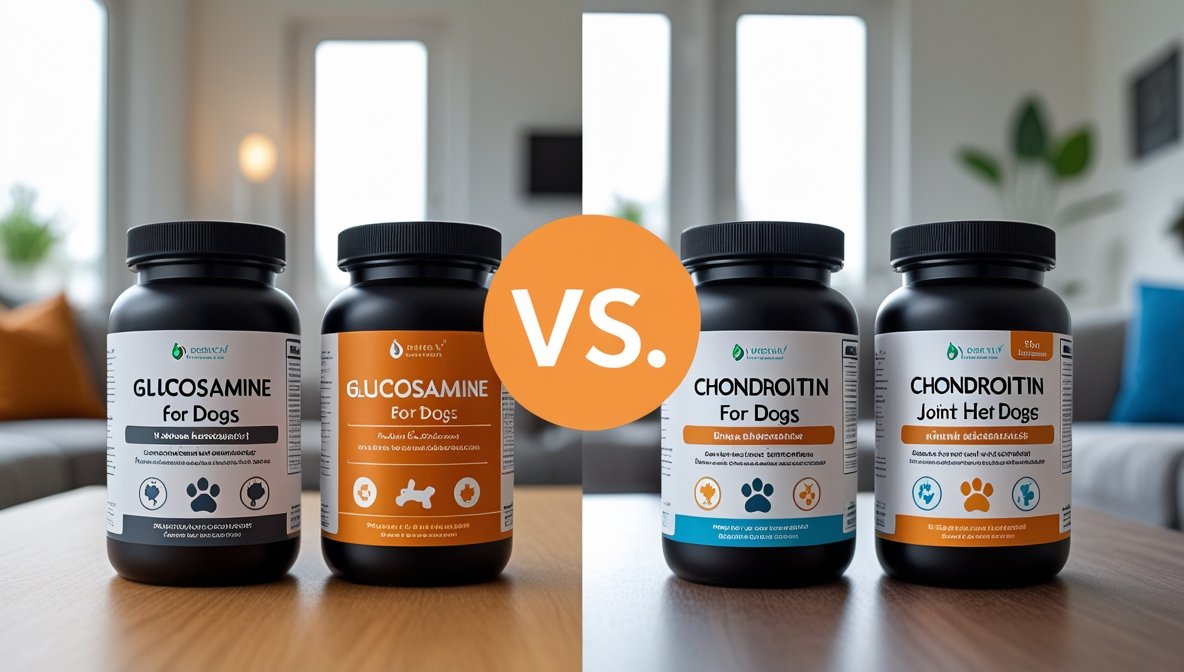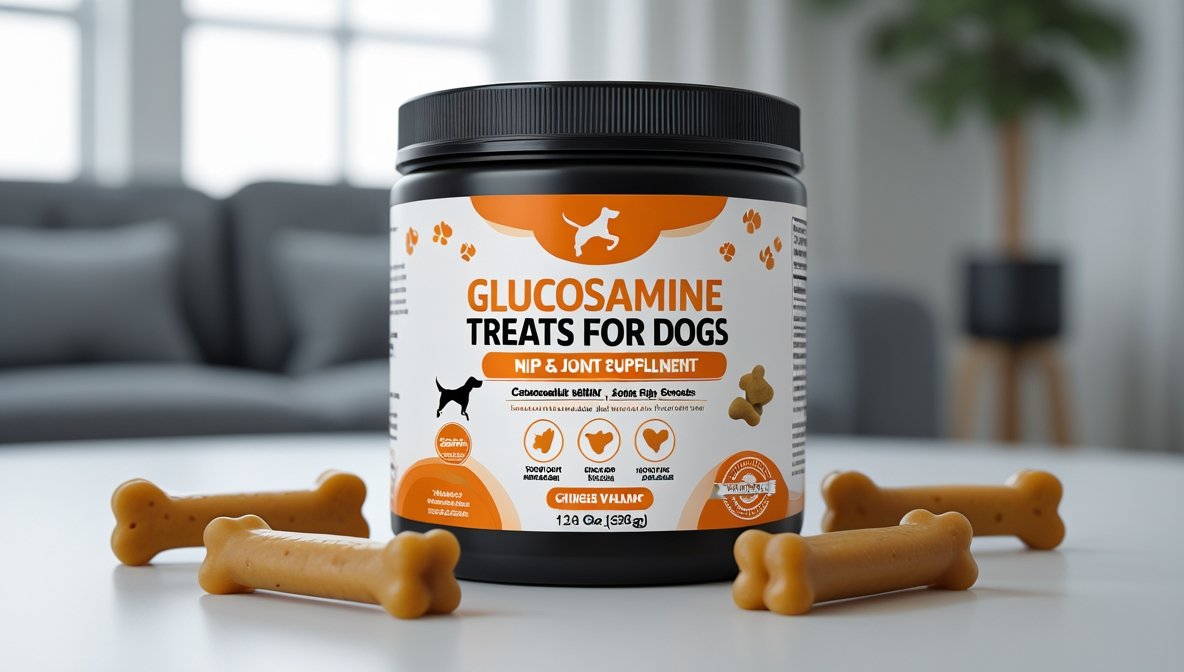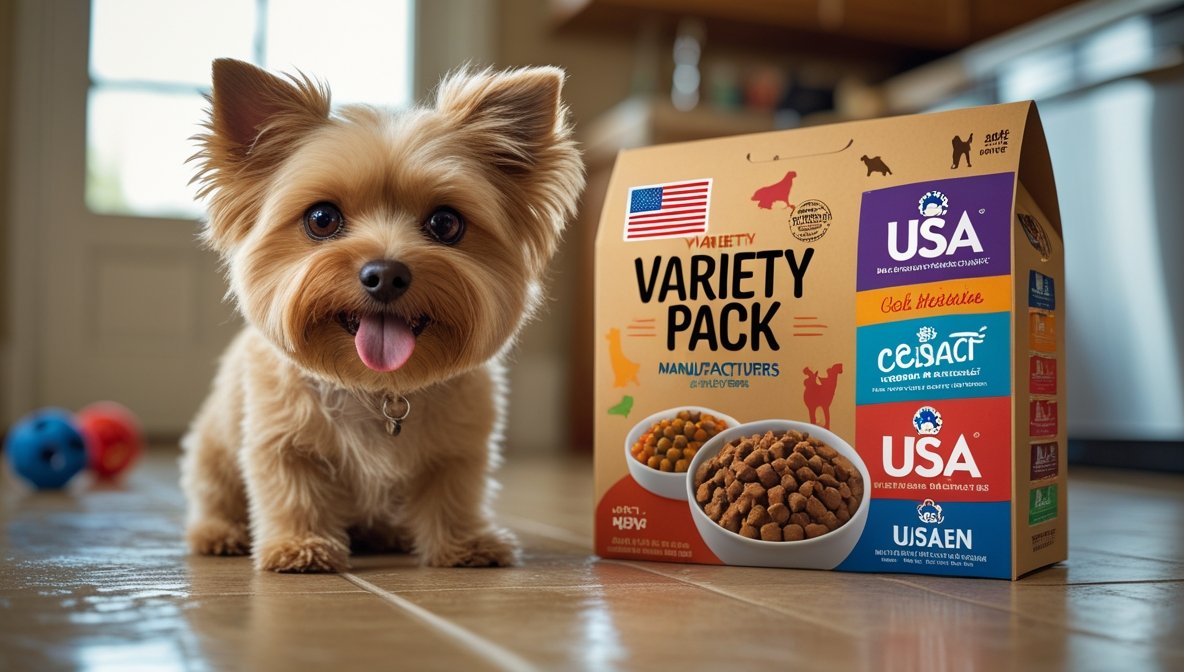Dogs of all breeds and ages often experience joint stiffness or arthritis. Pet owners frequently ask: “Is glucosamine or condroitine better for my dog?” (Note: “condroitine” is a common variant spelling of chondroitin.) Glucosamine and chondroitin are two of the most popular joint health supplements for dogs, often combined in hip and joint formulas. In this comprehensive guide, we’ll compare glucosamine vs condroitine for dogs, explain how each supports joint health, and provide practical advice on choosing the right supplement for your dog’s needs glucosamine vs condroitine for dogs.
Joint support supplements like glucosamine and chondroitin aim to rebuild cartilage, lubricate joints, and reduce inflammation. By understanding the role of each ingredient, dog owners can make informed choices. We’ll cover the benefits of glucosamine for dogs, the benefits of chondroitin for dogs, their key differences, how they work together, appropriate dosages and forms (chews, liquid, powder), and considerations for large breeds, small dogs, senior dogs, and even cats. You’ll also find expert tips, relevant statistics, and FAQs to help you boost your dog’s mobility and quality of life glucosamine vs condroitine for dogs.
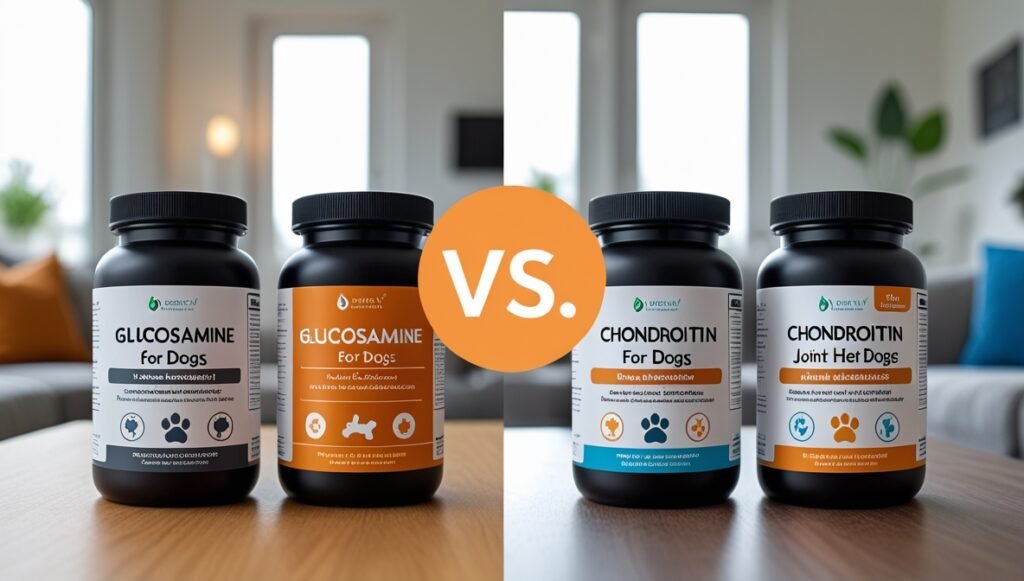
Table of Contents
Understanding Joint Supplements: Glucosamine vs Condroitine for Dogs
Image: A happy gray dog chewing a stick on green grass, illustrating healthy joints and mobility with glucosamine and chondroitin support.
Glucosamine and chondroitin are naturally occurring compounds found in healthy cartilage. In dogs, these nutrients help maintain the cushioning between joints. As pets age or experience joint wear (due to breed, activity, or injury), natural levels of glucosamine and chondroitin decline. Supplementing your dog’s diet with these compounds can support joint structure and function. Vets often recommend glucosamine and chondroitin supplements for dogs with osteoarthritis or hip dysplasia, as these ingredients help protect and rebuild cartilage.
What Is Glucosamine?
Glucosamine is an amino sugar that serves as a building block for joint cartilage and synovial fluid. It helps the body make glycosaminoglycans, a major component of cartilage. In effect, glucosamine is like a “cartilage builder.” According to veterinary experts, glucosamine promotes joint health by encouraging cartilage cell growth and reducing inflammation in the joints. It is sourced naturally (often from shellfish shells) and is available as glucosamine hydrochloride or glucosamine sulfate in supplements.
Glucosamine supplements are generally safe for dogs. Side effects are rare but can include mild upset stomach or increased thirst at very high doses. Veterinarians note that glucosamine is often most effective for mild to moderate arthritis, and many owners use it preventively in aging or high-risk dogs glucosamine vs condroitine for dogs.
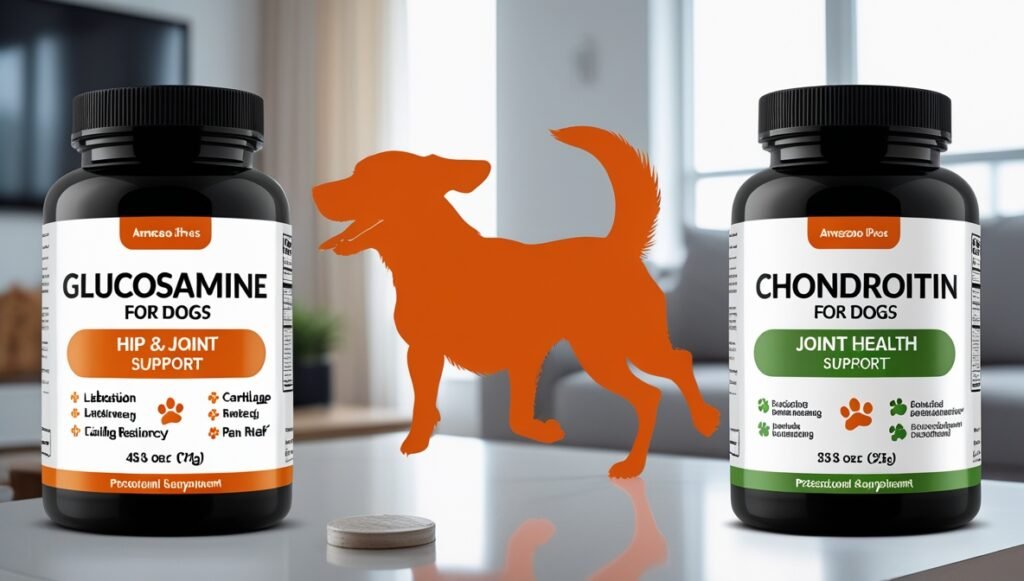
What Is Chondroitin (Condroitine)?
Chondroitin (sometimes spelled condroitine) is another key component of cartilage. It helps cartilage resist compression and retain water, keeping joints well-lubricated. In other words, while glucosamine helps build cartilage, chondroitin helps keep it strong and elastic. Chondroitin inhibits enzymes that break down cartilage, and it stimulates the synthesis of new cartilage components. It also has mild anti-inflammatory properties that soothe joint pain glucosamine vs condroitine for dogs.
Like glucosamine, chondroitin is often derived from natural sources (such as cow or pig cartilage, or shellfish shells). It is widely used in veterinary supplements for canine osteoarthritis. Because glucosamine and chondroitin work on different aspects of joint health, they are often paired together in supplements to provide comprehensive support.
Glucosamine vs Condroitine: Key Differences
- Chemical Role: Glucosamine is primarily a building block for cartilage and synovial fluid. It acts as a natural anti-inflammatory agent and helps rebuild cartilage tissue. In contrast, chondroitin’s role is to maintain cartilage integrity. It prevents cartilage breakdown and draws fluid into the joint, enhancing shock absorption.
- Action: Glucosamine encourages cartilage production and repair; chondroitin protects existing cartilage by inhibiting destructive enzymes. Together, they address different facets of joint degeneration.
- Scientific Consensus: Research on glucosamine and chondroitin in dogs is mixed. Some studies report moderate benefits for osteoarthritis, while others show minimal effect. However, clinical experience suggests that the combination of both supplements often yields better results than either alone glucosamine vs condroitine for dogs.
In practice, many veterinarians recommend using both glucosamine and chondroitin together for joint support. In fact, glucosamine “seems to work better when it is combined with chondroitin”. The key differences matter less than their complementary effects: together, they can help reduce cartilage breakdown, encourage repair, and improve joint lubrication and comfort.
Benefits of Glucosamine for Dogs
Glucosamine is widely used to alleviate joint pain and stiffness in dogs. Key benefits include:
- Cartilage Support: Glucosamine boosts the repair of damaged cartilage (the spongy cushioning in joints), helping to maintain or improve joint structure.
- Reduced Inflammation: As a mild anti-inflammatory, glucosamine can decrease joint swelling and pain associated with arthritis.
- Improved Mobility: Dogs taking glucosamine often show better mobility, longer active sessions, and increased willingness to run and jump (especially seen in senior or arthritic dogs).
- Safe for Long-Term Use: Glucosamine has a very safe profile. It’s non-drug (nutraceutical) and can be used long-term to manage chronic conditions. High doses can cause very mild side effects like upset stomach or increased thirst.
Glucosamine may also have additional benefits: by stimulating joint fluid production, it helps keep joints well-lubricated. And because glucosamine has a protective effect, some owners start giving it to young active or large-breed dogs as a preventative measure. According to the AKC, glucosamine is “often used as an early intervention and throughout the progression of arthritis” due to its safety glucosamine vs condroitine for dogs.
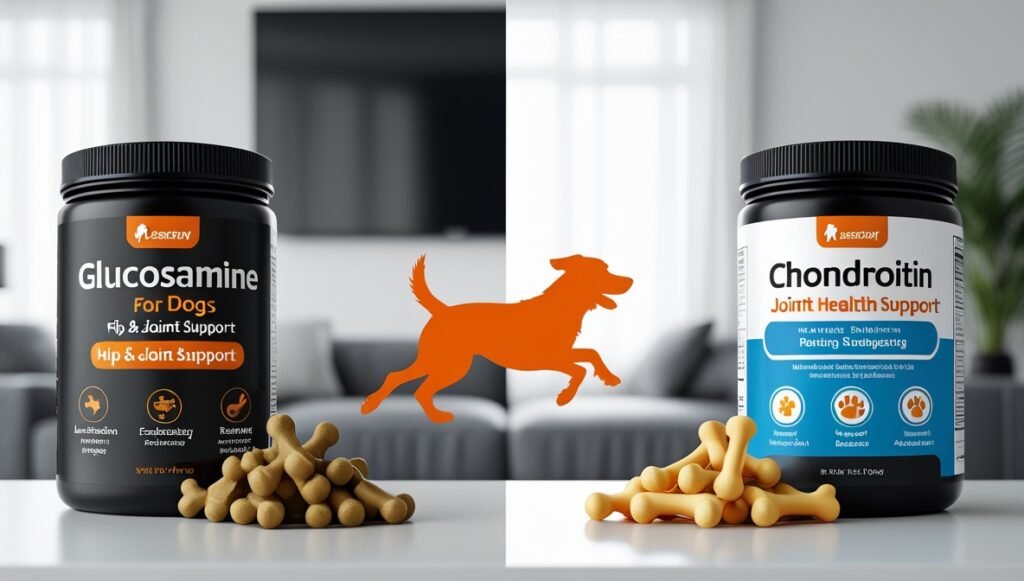
Benefits of Chondroitin for Dogs
Chondroitin complements glucosamine with its own set of benefits:
- Cartilage Protection: Chondroitin helps maintain cartilage thickness by drawing fluid into the cartilage matrix. This improves shock absorption in the joint.
- Prevents Cartilage Breakdown: By inhibiting enzymes that destroy cartilage, chondroitin slows the degeneration process in arthritic joints.
- Additional Lubrication: Like glucosamine, chondroitin increases the production of synovial fluid. This fluid is vital for lubricating joints and reducing friction.
- Mild Anti-Inflammatory: Although not as strong as pharmaceutical NSAIDs, chondroitin does have anti-inflammatory properties that help ease joint discomfort.
- Extra Benefits: Chondroitin may also support urinary tract health in cats (and possibly dogs) by strengthening connective tissues, as seen in treatment of feline lower urinary tract disease.
Regular chondroitin supplementation can thus reduce pain and swelling from osteoarthritis, improve range of motion, and enhance overall joint function. Many pet owners report that dogs on chondroitin-charged formulas seem more lively and less stiff. Like glucosamine, chondroitin is generally safe with minimal side effects (some dogs may have mild gas or loose stools).
Glucosamine and Chondroitin Together: The Synergy
One of the most important points about these supplements is that they work best in combination. Veterinary sources note that glucosamine “appear[s] to be more effective in combination than either substance is alone”, leading to better joint support. Here’s why the combo is powerful: glucosamine vs condroitine for dogs.
- Glucosamine builds cartilage while chondroitin protects it. Together, they not only help repair existing damage but also guard against further breakdown.
- Both boost synovial fluid production, providing a cushion that helps joints move more smoothly and with less pain.
- The combination addresses multiple pathways: enhancing cartilage formation (glucosamine) and inhibiting loss (chondroitin).
- PetMD highlights that together these supplements can prevent or reduce cartilage breakdown, help repair cartilage, increase joint fluid production, and decrease inflammation and pain glucosamine vs condroitine for dogs.
Because of this synergy, most joint supplement products for dogs contain both ingredients. For example, popular formulas like Cosequin, Dasuquin, and GlycoFlex include glucosamine hydrochloride plus sodium chondroitin sulfate, often alongside other ingredients like MSM or green-lipped mussel. Using them in tandem is a holistic approach; think of glucosamine as the builder and chondroitin as the protector of your dog’s joints glucosamine vs condroitine for dogs.
Key Benefits of Combined Glucosamine & Chondroitin:
- Prevents further cartilage degeneration
- Supports cartilage repair and growth
- Improves joint lubrication and shock absorption
- Reduces inflammation and discomfort in osteoarthritic joints
Veterinarians often recommend a multimodal approach to arthritis. A regimen might include weight management, physical therapy, and joint supplements (glucosamine + chondroitin) alongside medications if needed. The goal is to maximize comfort and mobility. As one vet source puts it, glucosamine and chondroitin are used to try to keep performance dogs in peak condition and ease arthritic symptoms.
Choosing the Right Joint Health Supplement
When shopping for a joint health supplement, consider the following factors to ensure quality and proper dosing:
- Certification and Quality: Look for products vetted by the National Animal Supplement Council (NASC). NASC-approved brands have met quality and safety standards. PetMD notes that “the best options are made by reputable companies and have been vetted by the NASC”. Certified supplements are more likely to contain the ingredients in the stated amounts.
- Active Ingredients: Check that the supplement contains adequate amounts of glucosamine and chondroitin (commonly around 500 mg each per dose, depending on dog size). Some formulas also include MSM, hyaluronic acid, omega-3s, or vitamins for extra joint support.
- Appropriate Strength: Large breeds generally need higher dosages than small dogs. A “glucosamine chondroitin for large dogs” product may have stronger concentrations. Conversely, “glucosamine for small dogs” often comes in smaller soft chews or tablets. Always follow the manufacturer’s guidelines or your vet’s advice based on weight and condition.
- Life Stage Formulas: Senior dogs often benefit from joint supplements formulated for older pets (sometimes labeled senior joint health supplement). These may include additional anti-inflammatories or antioxidants to help aging joints. Puppies and young dogs, especially large breeds, might get joint supplement preventative formulas to support developing cartilage.
- Forms and Convenience: Supplements come in several forms:
- Chews and Tablets: These are easy to give (often flavored). Look for joint health supplement for dogs chews or hip and joint supplement dogs chews for convenience.Liquid or Powder: Powders and liquids can be mixed into food. They allow precise dosing (especially useful for very large dogs or when swallowing pills is difficult). Examples include joint health supplement for dogs liquid or powder formulas.Soft Gels and Treats: Some products are marketed as soft treats or bites (“tasty chews”). These often appeal to picky eaters.
- Additional Ingredients: Some supplements add ingredients like boswellia, turmeric, or collagen for extra support. While these can be beneficial (reducing inflammation, supporting cartilage), they are not the same as glucosamine/chondroitin. Make sure to note any new ingredient in case of allergies glucosamine vs condroitine for dogs.
- Veterinarian Guidance: Always consult your vet before starting any supplement, especially if your dog takes medications. Although glucosamine and chondroitin have few interactions, your vet can recommend an appropriate brand, dosage, or need for additional therapies (like NSAIDs or physical therapy) glucosamine vs condroitine for dogs.
Anchor Text & Further Links: For authoritative guidance, refer to the National Animal Supplement Council (NASC) and veterinary sources. For example, Cornell University experts note that glucosamine and chondroitin “may help slow the progression” of arthritis in dogs. Such reputable sources can guide supplement choice and usage.
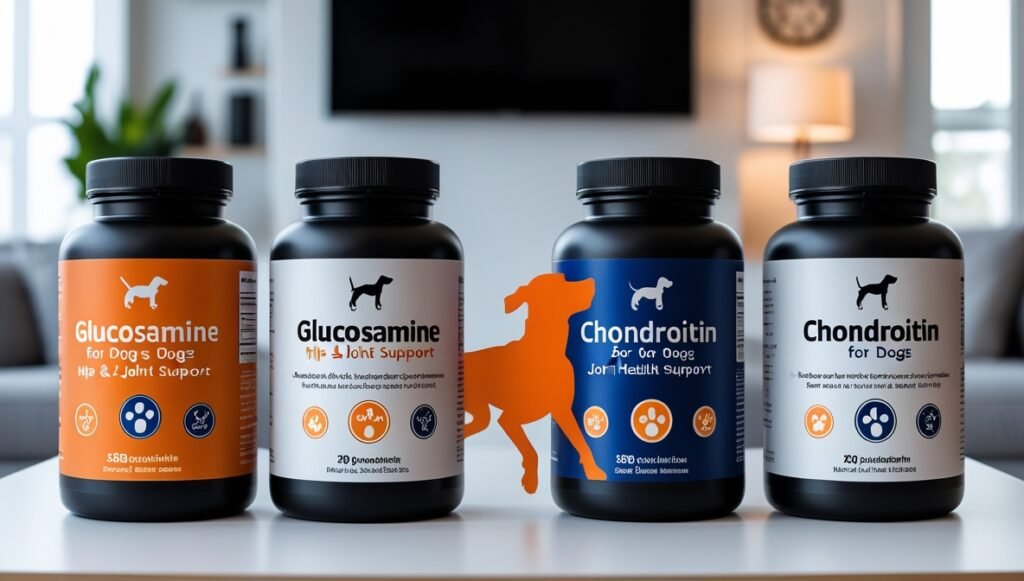
Joint Supplements by Pet & Breed
Large Breed vs. Small Breed Dogs
Joint issues vary by size. Large breeds (Labradors, German Shepherds, Golden Retrievers, etc.) are prone to hip dysplasia and arthritis due to their weight. They often require higher doses of glucosamine/chondroitin. A joint health supplement for large dogs typically contains larger pills or higher-strength doses. Some owners split daily doses (e.g., morning and night) to maximize absorption.
Small breed dogs have lighter weight but can still develop arthritis. They benefit from lower-dose formulations (joint health supplement for small dogs). Flavored chews or small tablets are available for tiny mouths. Regardless of size, maintaining a healthy weight is critical: even 1-2 pounds overweight in a small dog can significantly stress joints.
Senior Dogs and Puppies
Senior Dogs: As dogs age (usually over 7 years, or 5 for giant breeds), cartilage naturally thins and inflammation increases. Senior dogs often show glucosamine vs condroitine for dogs stiffness after resting or reluctance to jump. For senior dogs, look for formulas labeled for older pets. These often include added antioxidants (like vitamin C/E) or anti-inflammatories to relieve age-related joint pain. Early use of joint supplements (around 5–7 years) can be preventive glucosamine vs condroitine for dogs.
Puppies and Young Dogs: Certain large-breed puppies (Great Danes, Mastiffs, etc.) are at risk for developmental joint issues (hip/elbow dysplasia). Some vets recommend joint supplements during growth to support cartilage development. However, do not give young dogs adult doses; always use puppy-specific supplements or dose by weight. Good nutrition (calcium/phosphorus balance) and controlled exercise also help healthy joint formation glucosamine vs condroitine for dogs.
Dogs with Specific Conditions
Dogs with Arthritis or Dysplasia: If your dog is diagnosed with osteoarthritis or hip dysplasia, glucosamine/chondroitin supplements are often part of a long-term management plan. These cases may also include prescription treatments (like anti-inflammatory meds or cartilage injections), with supplements as an adjunct glucosamine vs condroitine for dogs. As one review noted, glucosamine supplements provided a “moderate level” of comfort comparable to some prescription drugs glucosamine vs condroitine for dogs.
Working and Active Dogs: Dogs with high activity levels (working breeds, agility dogs) put more stress on joints. Even if young, they may benefit from maintenance doses of joint supplements. Some handlers give daily glucosamine/chondroitin to keep joints lubricated and muscles limber glucosamine vs condroitine for dogs.
Glucosamine/Chondroitin for Cats
Cat owners can also consider joint supplements, especially for aging felines. Glucosamine benefits for cats include supporting mobility and potentially urinary tract health. Cats naturally make less cartilage-protecting compounds as they age, so a glucosamine supplement for cats can ease stiff joints and help with feline cystitis issues. Many supplements made for cats combine glucosamine, chondroitin, and green-lipped mussel. Always use cat-specific products, as cat metabolisms differ from dogs.
PetMD and veterinary sites affirm that glucosamine/chondroitin are used in “both dogs and cats” to treat osteoarthritis and even urinary tract issues. For example, glucosamine’s anti-inflammatory support can ease arthritis pain in older cats, while chondroitin’s cartilage benefits apply equally to felines. Dosages are lower and should be vet-guided. Many joint supplements marketed for dogs and cats meet these needs glucosamine vs condroitine for dogs.
Potential Side Effects and Safety
Glucosamine and chondroitin are generally very safe. Most dogs tolerate them well. Possible mild side effects include:
- Gastrointestinal Upset: Some dogs may experience gas, loose stools, or mild stomach upset when starting supplements. These usually resolve quickly. Giving supplements with food can help glucosamine vs condroitine for dogs.
- Allergies: Since many glucosamine/chondroitin come from shellfish, dogs with seafood allergies could react. (However, most studies find shellfish-allergic dogs usually tolerate these supplements.) If concerned, choose products sourced from plants or non-shellfish (some brands use fermented glucosamine) glucosamine vs condroitine for dogs.
- Increased Thirst or Urination: Very high doses of glucosamine might cause temporary increased drinking and urination. Monitoring dosage is important glucosamine vs condroitine for dogs.
- Interactions: These supplements are often safe to use with other treatments. Still, if your dog is on medications (like NSAIDs for pain), inform your vet. The VCA notes caution when dogs have conditions like asthma or when giving to pregnant/lactating pets.
Importantly, side effects are uncommon. Both substances have what experts call “benign adverse effect profiles”. Many veterinarians consider them first-line, low-risk options for arthritis management. Unlike NSAIDs, they do not typically cause liver or kidney issues at normal doses. The AVMA notes that glucosamine/chondroitin are safe even for long-term preventive use. However, because supplements are not FDA-regulated as strictly as drugs, quality and ingredient consistency can vary. Always choose trusted brands.
Frequently Asked Questions (FAQs)
Q: Is glucosamine or chondroitin better for my dog’s joint pain?
A: They serve different roles: glucosamine builds cartilage, chondroitin preserves it. Most experts find the combination more effective than either alone. It’s not typically “either/or” – for best joint health, use a supplement containing both.
Q: How long does it take to see results?
A: Joint supplements take time. Glucosamine vs condroitine for dogs may take 4–6 weeks or more of consistent daily use to notice improvement in mobility or pain levels. (The VCA notes improvements are gradual, usually seen after a few days to weeks.) Continue for at least 6–12 weeks, unless side effects appear. For long-term management, maintain daily dosing even when your dog feels better glucosamine vs condroitine for dogs.
Q: At what age should I start giving glucosamine or chondroitin?
A: It depends on the dog. Senior dogs or those showing arthritis signs can start anytime. Some vets suggest starting joint supplements around 1–2 years old for large or high-activity breeds as a preventative measure. Always follow your vet’s advice; supplements should not replace a healthy diet and exercise plan glucosamine vs condroitine for dogs.
Q: Can cats take these supplements?
A: Yes, there are cat-formulated glucosamine/chondroitin products. Cats can benefit similarly, especially older cats with arthritis. Cats also sometimes experience urinary tract issues that glucosamine may help improve. Use only products labeled for cats and check with your veterinarian for proper dosing.
Q: Should supplements be given with food?
A: Generally, yes. Giving glucosamine/chondroitin with a meal can reduce any stomach upset. Liquid formulas should be measured carefully but can be added to food or water. Powder or soft chews are easy to mix into meals or offer as treats.
Q: Are there any alternatives to these supplements?
A: Other joint-support options include MSM (methylsulfonylmethane), hyaluronic acid, omega-3 fish oils, turmeric, and collagen. Many dog joint formulas include these. However, none have the specific cartilage roles of glucosamine and chondroitin. For severe cases, vets may prescribe medications or cartilage-building injections (like Adequan®) alongside supplements glucosamine vs condroitine for dogs.
Conclusion
Deciding between glucosamine vs condroitine for dogs doesn’t have to be an either-or question. In fact, experts agree that using both together usually provides the best joint support. Glucosamine helps your dog build and repair cartilage, while chondroitin helps protect and hydrate it. Combined, they work synergistically to reduce pain, improve mobility, and slow arthritis progression. Choosing a high-quality, vet-recommended supplement (especially one NASC-vetted) and giving it consistently can help keep your dog’s hips, knees, and shoulders moving smoothly through all life stages. Always tailor the product form and dose to your dog’s size and needs, and consult your veterinarian for personalized guidance. With the right joint health supplement regimen, many dogs enjoy longer, more active lives with less joint discomfort glucosamine vs condroitine for dogs.
Meta Title: glucosamine vs condroitine for dogs: Joint Supplement Guide
Meta Description: Discover benefits of glucosamine vs condroitine for dogs. Learn how each supports joint health in large, small, senior dogs and cats. Expert tips and FAQs.

